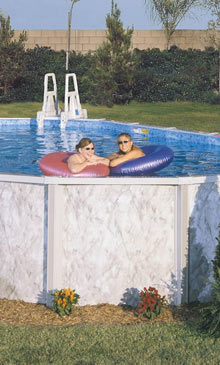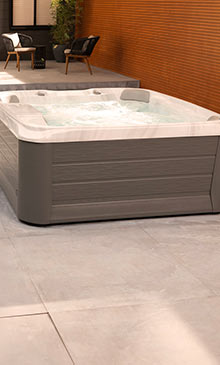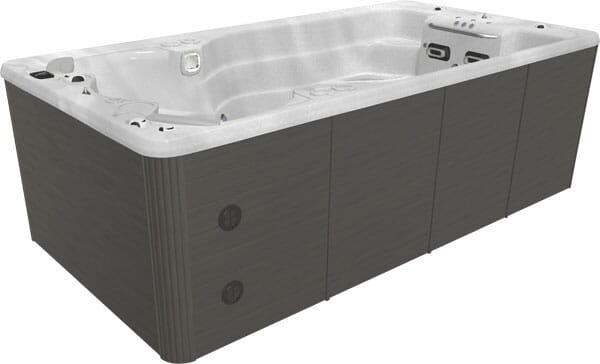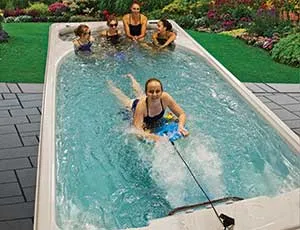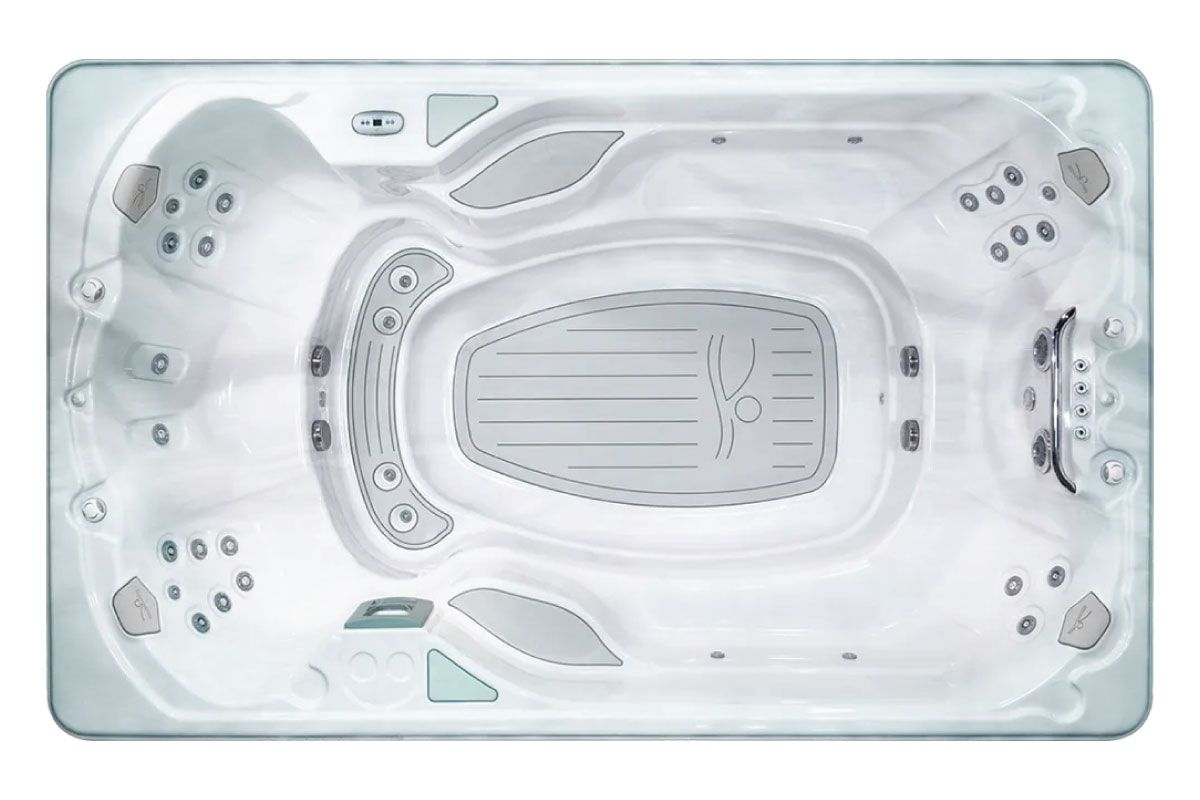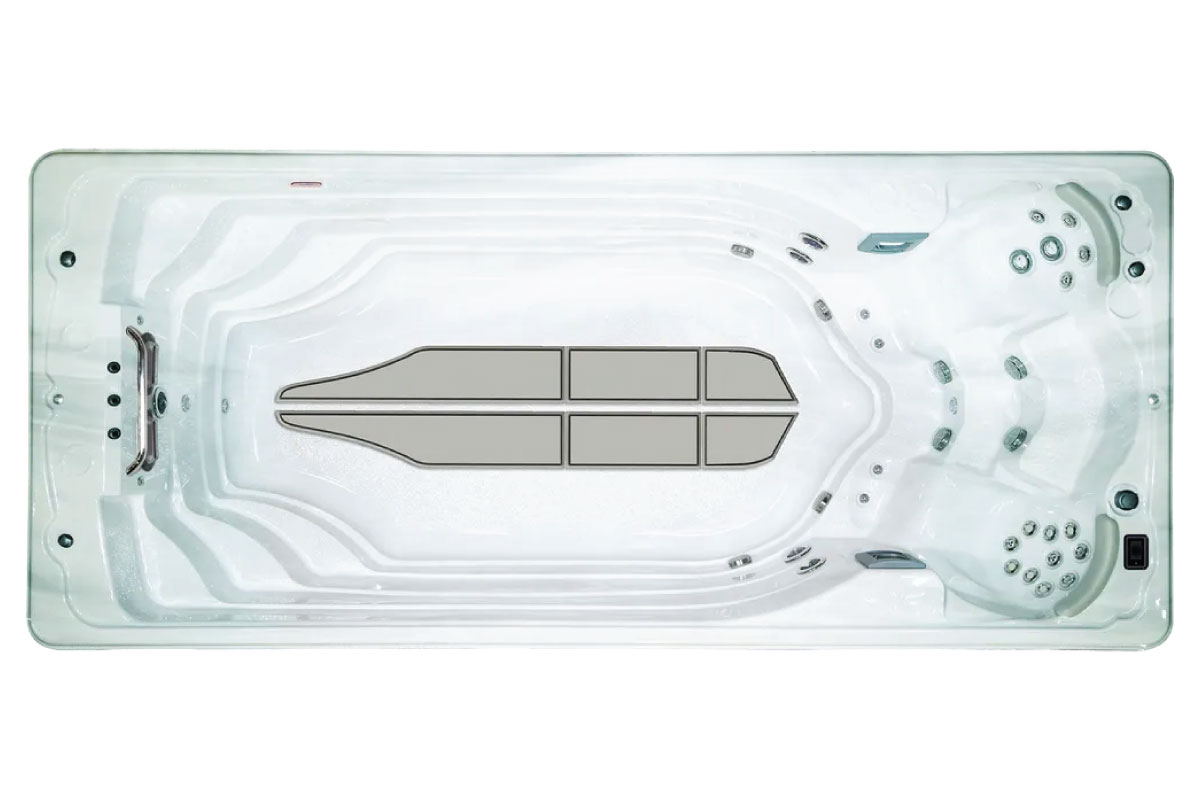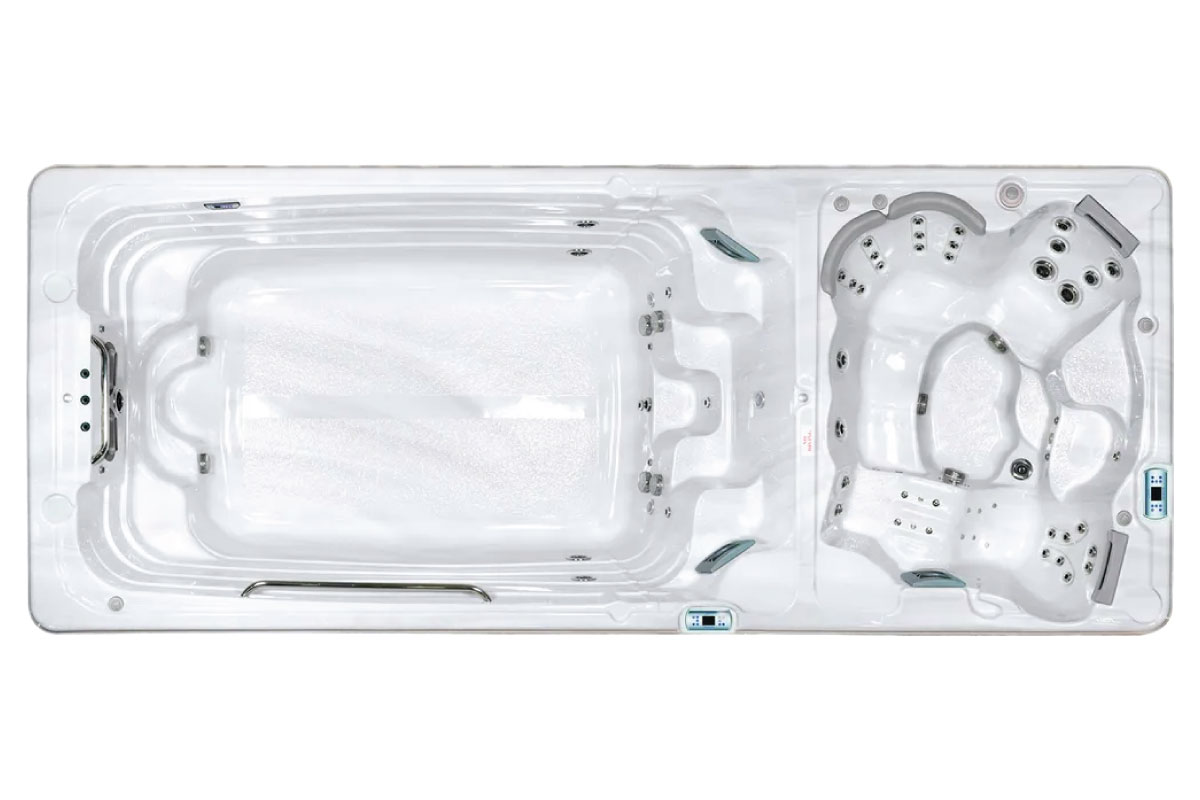Swim Life AquaStream Swim Spa
The Aquastream SwimFit swimspa is a versatile underwater gym, combining powerful swim jets and cross-training functionality for optimal workouts and superior water management.

Product Highlights
Delivery & Install Includes:
Colors Available
In Stock
Have Questions?
Speak to a SpecialistDelivery includes:
- Provides professional delivery personnel to deliver a spa to a customer’s home and place it in its location.
- Basic hookup within 6 feet of hot tub to an electrical junction box (disconnect box)
Delivery does NOT include:
- Supplying electrical work to bring power to the hot tub location
- Difficult to access location (fence removal, decks, rock walls, etc)
- Does not include up or down staircases
- Does not include use of crane or material handler/forklift
The customer is responsible for a building permit, leveling, site preparation, delivery route for spa placement, and electrical prep and connections,
Product Description
If you love to have fun when you workout, the Aquastream SwimFit swimspa is for you! The Swimfit Sereis combines powerful swim jets with cross-training functionality for maximum range of motion. Its unique layout and standard equipment make it an extremely versatile underwater gym. It is also the first swimspa to incorporate the best water management in the industry, giving you clean, sparkling water during every workout!
AquaStream Features
Explore our innovative hot tub features
AquaStream Specs
| Volume (G): | 2400 Gal |
| Dry Weight (Lbs): | 2660 Lbs |
| Filled Weight (Lbs): | 22760 Lbs |
| Length (in): | 210" |
| Width (in): | 93" |
| Height (in): | 53" |
| Hydrotherapy Seats: | 2 |
Schedule A Wet Test
The best way to see if this swim spa is right for you is by trying it out for yourself. It's best to experience the relaxing sensation of hydrotherapy before you purchase.
Swim Spa FAQs
For those yet to discover the wonderful world of swimming spas, there are an inordinate number of benefits that can be derived from these amazing and enjoyable units. Not only is swimming great exercise, it can lead to clarity of the mind and a positive self-image. And this doesn’t even begin to describe the fun, joy, and sense of freedom that swimming can provide. But in this day and age of body consciousness, one of the most frequently asked questions is if swimming can help with weight loss. Can you lose belly fat by swimming? To examine these questions further, we’ve put together an article to figure out if using your swim spa can affect the size and shape of specific body parts.
Warming up
Before you begin to even think about losing weight and burning belly fat through a swimming workout, you need to begin with a proper warm up. Failure to do so will not only inhibit your overall performance, it can lead to injury which will set your weight loss goals back even further. A proper warm up should begin on dryland with some stretching and calisthenics. What you want to do is get your blood flowing to all your muscles while preparing them for explosive use. Once you get in the water you should swim 10 to 15 minutes at a moderate pace before really cranking things up. This will get you prepared for your actual workout.
Swimming technique
One of the beautiful things about exercising in water is that you’re able to perform movements that would be difficult, if not impossible, on dry land. If losing belly fat and strengthening your stomach muscles are your main priorities, you should be keeping those in mind during your workout. Keep your stomach muscles tight. When swimming on your front, pull your stomach muscles taut and upwards rather than letting your belly hang low. When swimming on your back concentrate on crunching your abs while still keeping your butt as high as possible. Simply being aware of how your stomach muscles are being used (or not!) can make a big difference in muscle development.
Get a cardiovascular workout
The best way to burn fat is to increase your heart and breathing rates. What you’re looking to do is get your heart rate into what’s known as the fat burning zone and maintain it for as long as possible. The fat burning zone is considered to begin at around 70% of your maximum heart rate. The simplest calculation of maximum heart rate is to subtract your age from 220. For example, a 20 year old would have a maximum heart rate of 200 beats per minute (bpm) while a 40 year old would have a maximum heart rate of 180 bpm. Therefore the fat burning zone for a 20 year old would be 140 bpm while for a 40 year old it would be 124bpm. And although monitoring your heart rate while swimming was never the easiest thing, today’s fitness devices make this a whole lot easier. All you need to do is coordinate the strength of the swim spa current to your personal fat burning zone and your fat burning workout is ready to begin.
Swimming aids
Almost without exception, top ranked swimmers will use swimming aids such as kickboards and weight belts to isolate muscle groups and increase the intensity of their workouts. For those focused on the stomach, employing a kickboard while laying on your back and using only your legs for movement will isolate the stomach muscles. Using a weight belt will increase the effort needed to stay afloat no matter what stroke you’re performing and will ultimately end up in more calories being burned.
For a swimming fanatic, there are few things in the world that are more freeing than being able to step out of your house and jump into the water. The ability to swim whenever you want without having to worry about pool hours or transportation to and from the pool is a swimmer’s dream. But what about taking it one step further by being able to swim in your basement? And while you might not have the space for a full sized indoor swimming pool, there’s always the possibility of a swim spa. Can you put a swim spa in a basement? Aside from a few logistical considerations, there’s no reason why. In this article, we’ll go over some of those considerations to help make a basement swim spa a reality for you.
Access
At the beginning, the main thing you should consider is whether you can get the swim spa into your basement. You don’t want to get it stuck on the stairs with no way to get down or back up. Comparing the dimensions of your swim spa with the measurements of the path to your basement is crucial. Doorway sizes, ceiling clearances, and tight corners should all get detailed attention.
Drainage
No matter how careful everyone is, water is going to get spilled onto the floor. For this reason, and for the instances where you need to empty your swim spa, proper drainage is a must. The drain should definitely be in the same room as the swim spa. In fact, the location of any basement drains will likely dictate where the swim spa should be installed. You’ll also want your floor graded to allow water to easily flow towards the drain without any obvious pooling.
Ventilation
An indoor swim spa will create a lot of humidity. This will only be increased if you’re installing the swim spa in your basement. There’s also the possibility of a chlorine smell that you probably don’t want wafting throughout your entire house. For this reason, proper ventilation is necessary. A strong exhaust fan coupled with a ceiling fan can help keep the air circulating and prevent excessively humid conditions.
Floor
A concrete basement floor can make an ideal base for the weight of a swim spa. However, you also want a flooring material that prevents the absorption of water while providing a slip-free surface. This could simply mean sealing the concrete with a floor sealant or laying down another flooring material such as tile or rubber.
Walls and ceiling
Again, humidity caused by the swim spa can wreak havoc on the structure of the house if not properly contained. You’ll want to install a vapour barrier along the walls and ceiling of the room containing the swim spa. This is typically a thick plastic sheeting that’s sealed to be airtight, but there are also those who have used a waterproof polyurethane spray foam This will protect wooden beams, joists, and studs as well as the insulation from humidity. Any drywall that’s installed will also need to be waterproof. Doing this job properly will protect against humidity problems such as wood rot, mold, and mildew.
Swim spa cover
Even though you might not need to be worried about leaves, insects, and other debris falling into an indoor swim spa, you should still employ a properly fitting cover whenever the swim spa isn’t in use. This will minimize evaporation, decrease the room’s humidity, and reduce the likelihood of condensation. Conscientious use of the swim spa cover will greatly reduce problems that are often associated with high humidity and allow you to rely less on air ventilation systems to keep the humidity levels in check.
For those who don’t have enough room in their backyard or house to install a full sized swimming pool, a swim spa can be a great alternative. A swim spa allows one to practice all the different swim strokes while being kept in place by a strong current. The effect is much like that of a dryland treadmill for walking or running while allowing the swimmer to use a much smaller water tank compared to a full sized swimming pool. As an added bonus due to their small size, the water temperature of the swim spa can be cranked up to replicate that of a hot tub. There’s no possibility that you could ever get the water temperature of your full sized swimming pool that high.
But when it comes to swim spas, do they offer the same installation possibilities as a swimming pool? Can you put a swim spa inground?
The fact is that it’s entirely possible to install an inground swim spa. And for those who don’t like the bulky appearance of the above ground models, this can be an important selling point. In this article we’ll go over the installation of inground swim spas and other benefits.
Above ground versus inground swim spas
One of the main differences between above ground and inground swim spas is their appearance. Above ground swim spas are typically completely self contained units with the plumbing and heating systems hidden within the cabinet that surrounds the water tank. This can make them appear quite large and bulky and difficult to attractively integrate into your backyard.
Inground swim spas, on the other hand, hide most, if not all, of the mechanical components underground leading to sleek, low profile appearance. For those who want something to harmoniously blend into the surrounding area, an inground swim spa might be more desirable.
Ease of installation is another matter. An above ground swim spa can simply be placed on any stable, level surface and be soon up and running. The inground swim spa, as the name suggests, will require some excavation and construction work as well as some foresight when it comes to future electrical, plumbing and maintenance access. This will necessarily increase the cost and duration of the installation process.
Both types of swim spa will require attention paid to the ideal location, delivery access, drainage, ground preparation and electrical and plumbing access.
Swim spa benefits
When compared with a full sized swimming pool there are many benefits for the potential owner. An inground swim spa is much cheaper to install and operate compared to a full sized inground pool. Swim spas take up much less space while using less water, fewer chemicals and less electricity than the full sized pool. This also allows the swim spa to be used throughout the winter as the smaller body of water is much easier to keep heated.
Swim spas allow for several different types of exercise. Although primarily used for swimming, they can also be outfitted with accessories that allow for resistance training, walking, jogging, rowing and more. Competitive open water swimmers often prefer training in swim spas because the current strength can be tailored to mimic the conditions of an open body of water. And as mentioned in the introduction, the temperature can be raised to 40 degrees Celsius, the same temperature found in hot tubs.
For those who enjoy the privacy of swimming in their own backyard but have limited space for a full sized swimming pool, a swim spa can be a happy compromise.
A swim spa is a small, temperature-controlled pool that allows you to swim, exercise, and relax in the comfort of your own backyard. A swim spa has a current on one end that lets you swim in place, as well as seats with hydrotherapy jets and other fitness options. A swim spa is larger than a hot tub but smaller than a traditional swimming pool.
A swim spa offers many benefits for your health, fitness, and lifestyle. some of the benefits are:
- You can swim, jog, bike, or row in the water, which provides a low-impact, full-body workout that burns calories, strengthens muscles, and improves cardiovascular health.
- You can enjoy the therapeutic effects of warm water, which can ease muscle tension, reduce stress, improve circulation, and promote relaxation.
- You can have fun with your family and friends, as a swim spa can accommodate multiple people and offer entertainment features like led lights, bluetooth speakers, and waterfalls.
- You can use your swim spa year-round, regardless of the weather or season, as most models have energy-efficient heating and insulation systems.
- You can save space and money, as a swim spa requires less installation and maintenance costs than a traditional pool, and can fit in smaller or irregularly shaped backyards.
The cost of a swim spa depends on various factors, such as the size, quality, features, installation, and maintenance of the model. In general, a swim spa can cost anywhere from $10,000 to $65,000 or more, with an average cost of around $25,000 to $40,000. You may also need to consider additional costs, such as electrical wiring, plumbing, landscaping, permits, and accessories.
There are many factors to consider when choosing a swim spa, such as:
- Your budget and preferences. You should have a clear idea of how much you are willing to spend and what features you are looking for in a swim spa. You may want to compare different models and brands to find the best value and quality for your money.
- Your available space and location. You should measure your backyard and check the local codes and regulations for installing a swim spa. You should also consider the access and delivery options, as some swim spas may require a crane or a forklift to be placed in your backyard.
- Your desired swim experience and fitness level. You should choose a swim spa that has a swim current system that suits your swimming style and ability. Some swim spas use jet propulsion, which creates a turbulent and adjustable current. Others use propeller or paddlewheel systems, which create a smoother and more powerful current. You should also look for other fitness options, such as an underwater treadmill, an exercise bike, or resistance bands.
- Your comfort and relaxation needs. You should choose a swim spa that has comfortable seats, ergonomic design, and hydrotherapy jets. You may also want to look for other features that enhance your relaxation, such as dual temperature zones, aromatherapy, waterfalls, and mood lighting.
Installing a swim spa requires careful planning and preparation. We’ll walk you through the swim spa install process and make it a pleasurable experience for you. Some of the steps involved in installing a swim spa are:
- Preparing the site. You should clear and level the area where you want to place your swim spa. You should also ensure that the site has a solid and flat foundation, such as a concrete pad, a reinforced deck, or a vault. You should also have access to electricity, water, and drainage.
- Delivering the swim spa. You should arrange for the delivery of your swim spa and make sure that there is enough space and clearance for the delivery crew to move the swim spa to your backyard. You may need to use a crane or a forklift if there are obstacles or narrow passages.
- Connecting the swim spa. You should hire a licensed electrician and a plumber to connect your swim spa to the power and water sources. You should also fill the swim spa with water and add the necessary chemicals to balance the water chemistry.
- Enjoying the swim spa. You should check the water temperature, the swim current, and the jets before using your swim spa. You should also read the owner’s manual and follow the safety and maintenance guidelines.
Maintaining a swim spa is essential to keep it clean, safe, and efficient. Some of the tasks involved in maintaining a swim spa are:
- Testing and balancing the water. You should test the water regularly with a test kit or a test strip and adjust the pH, chlorine, and other parameters according to the manufacturer’s recommendations. You should also shock the water with an oxidizer after heavy use or weekly to remove contaminants and restore clarity.
- Cleaning the filters. You should rinse the filters with a hose once a week and soak them in a filter cleaner once a month. You should also replace the filters every year or as needed.
- Draining and refilling the water. You should drain and refill the water every three to six months or as needed, depending on the water quality and usage. You should also clean the acrylic surface and the pipes with a spa cleaner before refilling the water.
- Covering the swim spa. You should always cover the swim spa when not in use to prevent heat loss, evaporation, and debris accumulation. You should also clean and condition the cover regularly to prevent mold and mildew growth.
Some of the common swim spa problems and their possible solutions are:
- Cloudy water. This can be caused by poor filtration, low sanitizer level, high pH, or high calcium hardness. You should check and clean the filters, shock the water, and adjust the water chemistry accordingly.
- Green or brown water. This can be caused by algae growth, metal contamination, or organic matter. You should shock the water, add an algaecide or a metal sequestrant, and run the filter for several hours. You may also need to drain and refill the water if the problem persists.
- Foamy water. This can be caused by soap residue, body oils, lotions, or high total dissolved solids. You should shock the water, add a defoamer, and rinse the filters. You may also need to drain and refill the water if the problem persists.
- Bad odor. This can be caused by low sanitizer level, high pH, or bacterial growth. You should shock the water, adjust the water chemistry, and run the filter for several hours. You may also need to drain and refill the water if the problem persists.
- Noisy pump. This can be caused by air in the pump, low water level, or worn bearings. You should bleed the air from the pump, add water to the swim spa, or replace the pump if the problem persists.
A swim spa can be energy-efficient and cost-effective if you follow some simple tips, such as:
- Choosing a swim spa that has a high-quality insulation system, a variable-speed pump, and an energy-efficient heater.
- Setting the temperature to the lowest comfortable level and using a dual temperature zone if available.
- Using a tight-fitting and insulated cover to prevent heat loss and evaporation.
- Cleaning and replacing the filters regularly to improve water circulation and filtration.
- Scheduling the swim spa cycles during off-peak hours or using a timer.
- Reducing the swim current speed and the jet intensity when not in use.
A swim spa can be safe and enjoyable if you follow some basic safety rules, such as:
- Never swim alone or leave children unattended in the swim spa.
- Keep the water temperature below 104°F and limit your soaking time to 15 minutes or less.
- Avoid using the swim spa if you have a medical condition, are pregnant, or are under the influence of alcohol or drugs.
- Keep the water chemistry balanced and sanitized to prevent infections and irritations.
- Keep the swim spa cover locked and secured when not in use to prevent unauthorized access and accidents.
- Keep electrical appliances and devices away from the swim spa to prevent electrocution and fire hazards.
The depth of a swim spa varies depending on the model and the design. Most swim spas are 4 to 5 feet deep, which is enough for most swimmers and exercisers. Some swim spas have deeper sections or adjustable floors that can increase the depth to 6 feet or more, which can be useful for diving or aquatic therapy.
Yes, you can use a swim spa in the winter. a swim spa allows you to enjoy swimming and other activities in warm water even when it’s cold outside.
Escape the winter doldrums
A swim spa lets you swim at your own schedule and convenience, without having to go to an indoor pool. you can also experience the refreshing feeling of swimming outdoors in the winter.
Soak away the cold
A swim spa can also function as a hot tub, with a maximum temperature of 40 degrees celsius. you can relax in the warm water and enjoy the massage jets while snowflakes fall on your head.
Vary your workouts
A swim spa offers more than just swimming. you can also walk, jog, row, or do resistance training in the water, using the current or special accessories. a swim spa gives you a variety of exercises to choose from.
Socialize with family and friends
A swim spa is spacious enough to accommodate your family and friends. you can have fun and bond with your loved ones in the comfort of your swim spa, even in the winter.
The importance of the swim spa cover
To use your swim spa year round, you need a well-insulated swim spa cover. this will keep the water warm and clean, and prevent unwanted access. you can also use a cover lifter to make opening and closing your swim spa easier.
Yes, you can walk in a swim spa and enjoy many benefits for your health and fitness. Walking in a swim spa can:
- Help people with arthritis and other joint problems by reducing the pressure and pain on their joints, and improving their balance and stability in the water.
- Allow you to use a water treadmill or the swim spa current to create a natural and low-impact walking or jogging exercise that can strengthen your muscles and burn calories.
- Increase your flexibility by relaxing your muscles, tendons and joints in the warm water, and allowing you to stretch further and easier.
- Reduce your pain levels by increasing your heart rate, blood circulation, oxygen and nutrient delivery to your tissues, and reducing inflammation and swelling.
- Enhance your healing capacity by boosting your immune system, and stimulating your cellular processes for tissue repair and healing.
Yes, swim spas have covers, and they are very important for swim spa maintenance and safety. Some of the benefits of using a swim spa cover are:
- Water Quality: A cover can prevent dirt, debris, insects, and other contaminants from getting into the water when the swim spa is not in use. This can help keep the water clean, fresh, and balanced, and reduce the need for chemicals and cleaning.
- Water Retention: A cover can reduce the amount of water that evaporates from the swim spa surface. This can help maintain the water level and the water chemistry balance, and save water and money.
- Heat Retention: A cover can act as an insulator that traps the heat in the water and prevents heat loss to the environment. This can help keep the water at a comfortable temperature, reduce the heating time and cost, and allow the swim spa to be used all year round.
- Safety: A cover can also act as a barrier that prevents children and animals from accessing the swim spa without supervision. A lockable cover can provide extra security and peace of mind.
The time it takes to heat a swim spa depends on several factors, such as:
- Location: Indoor swim spas heat faster than outdoor ones, especially in cold or windy weather. Sunny and sheltered spots can also speed up the heating process for outdoor swim spas.
- Size: Larger swim spas have more water to heat than smaller ones, so they may take longer to reach the desired temperature.
- Initial Water Temperature: If the water is already warm from previous use or from the source, it will heat faster than cold water.
- Water Heater Power: A more powerful water heater can heat the water more quickly than a less powerful one. This can be useful if you don’t use your swim spa regularly and want to heat it up fast when you do.
- Swim Spa Cover: A cover can help retain the heat in the water and prevent heat loss to the environment. Using a cover while heating the swim spa can reduce the heating time significantly.
On average, it takes about eight to ten hours to heat a swim spa from cold tap water to a comfortable temperature, using a cover and room temperature surroundings.
A swim spa can add value to your home in different ways, depending on the type of value you are looking for. Some of the factors that affect the value of a swim spa are:
- Property value: A swim spa can increase or decrease the property value of your home, depending on the neighbourhood, the design, and the presentation of the swim spa. If your swim spa matches the standards and expectations of your community, and is well integrated with the surroundings, it can make your home more attractive to buyers.
- Rental value: A swim spa can boost the rental value of your home, especially if you are using online platforms like Airbnb. A swim spa can attract more customers and allow you to charge higher rates, as it can create a sense of luxury and glamour for your guests.
- Personal well being: A swim spa can enhance the value of your personal well being, by providing a space for relaxation, exercise, and socializing. A swim spa can help you improve your physical and mental health, and increase your quality of life.
- Investment in quality: A swim spa can deliver more value if you invest in a high quality system that meets your needs and expectations. A quality swim spa can last longer, perform better, and give you more satisfaction than a cheap or low quality one.
A swim spa is a pool that allows you to swim against a water current. It can also be used for relaxation or entertainment. The size of a swim spa varies, but they are usually between 10 and 20 feet long, 6 and 8 feet wide, and 3 and 5 feet deep. Some swim spas can be customized to fit your space, while others have standard sizes. The size of your swim spa will affect how much water it holds, how strong the jets are, and how much it costs to maintain. You should consider your needs and budget before buying a swim spa for your home. To learn more about different sizes of swim spas, download a free buyer’s guide today.
Yes, you can put a swim spa on a deck, as long as the deck is strong enough to support the weight of the swim spa. A swim spa can weigh several tons when filled with water and people, so you need to make sure that the deck is reinforced with concrete footings, steel beams, or other structural supports. You should also consult with a professional engineer or contractor to evaluate the deck and the swim spa installation.
Factors Affecting Swim Spa Longevity
A swim spa can last for 25 years or more, depending on how well you take care of it. Some of the factors that affect the longevity of a swim spa are:
- Swim Spa Cleanliness: Keeping your water chemistry balanced, your filter cartridges clean, and your swim spa shell free of dirt and debris will prevent damage to the plumbing, heating, and filter system.
- Swim Spa Covers: Using a cover when the swim spa is not in use will protect it from the weather, debris, and heat loss. A cover will also prevent accidents and save energy costs.
- Swim Spa Component Maintenance: Checking the water pump, heater, plumbing, and cabinet regularly for any signs of wear and tear, leaks, or unusual noises will help you fix any problems before they become worse. Calling a professional service if you notice any issues will ensure your swim spa is repaired properly.
- Swim Spa Warranties: Most swim spas come with warranties that cover the shell and the components for a certain period of time. The warranties can vary depending on the manufacturer and the model, but they usually last for at least 10 years. The warranties are there to help you if something goes wrong with your swim spa that is not your fault.
